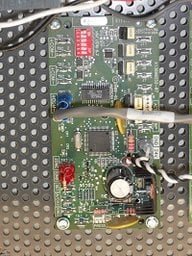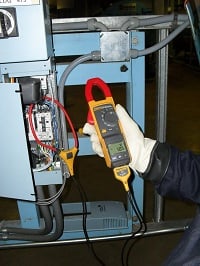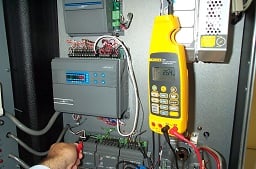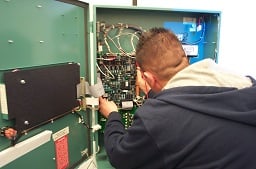By Ron Auvil

In my role as a senior project technician I spend a lot of time in buildings diagnosing problems. My responsibilities involve electronic controls on HVAC equipment. I also try to help the customer by diagnosing common problems with other equipment, which might include telephone systems, elevators, security equipment, and life safety systems.
Admittedly, while working on problems with these various systems I can be a little slow to note a common denominator. But over a period of time I have noticed something that repeats itself over and over again - problems due to power! Approximately 25 to 35 percent of the service calls I get are related somehow to a power issue of one type or another.
Prevalence of electronics
It does not take a genius to recognize that almost every major subsystem in today's commercial buildings has some type of solid-state electronics package installed. Virtually every HVAC unit purchased today has an electronics board in the control panel. Ditto for security, fire, and life-safety systems. Digital telephone and computer network systems are the same. Regardless of system type, the common element is the electronics. Another factor in this electronics equation is that there are "old" electronics and "new" electronics. Some electronic systems in today's building equipment were installed 20 or more years ago, and are even more susceptible to problems.
All of the electronic systems mentioned above can have problems due to power. Many electronics and device manufacturers will claim an amount of tolerance to power problems. Many will say that a fault due to power "should not" happen. Unfortunately the nice tech support folks on the other end of the telephone are not stuck on an elevator or listening to the fire alarms going off after a thunderstorm.
Typical power scenarios
Anyone working in a field utilizing electronics in a building should be able to easily recognize the scenarios that affect the power to the electronics. These scenarios typically are very repetitive in the building and in some cases occur frequently.
Lightning strike

One of the most common scenarios is a lightning strike. The prevalence of this problem will depend greatly on your location and climate. I happen to live in the southeastern United States, which is famous for summer thunderstorms in the afternoon. My personal rule of thumb is that after a thunderstorm moves through I will get at least one or two calls from a building that are lightning-related. Sometimes I can even watch weather radar and know exactly which of my buildings will be calling me.
Lightning can cause a whole host of problems. Keep in mind that a lot of the electronics, especially HVAC equipment, is located on the roof or outside the building. This makes it even more susceptible to lightning. If lightning is the culprit, its effects can be catastrophic. In many cases the electronics are wiped out, with visible burn marks and a burned smell.
Moving the electronics, as well as better lightning protection and grounding, can help.
If a computer program is running on an electronic chip in the device (EEPROM or Flash ROM) it may be wiped clean by the lightning strike and start up "stupid" - not operate at all. I have a building with old 1990s electronics that have to be reprogrammed after every major thunderstorm. It is not uncommon, after a power problem, that 1 to 5 percent of the devices on a building automation system network do not communicate or function properly.
Recently I received a call that the fireman's panel in a building was not functioning. This building has suffered from many power problems in the recent past, usually one every two weeks or so. The electronic controller in the panel had faulted out and had to be replaced. Obviously this was a critical system. The electronic controller was replaced and started up. It worked for a few seconds and then rebooted every 10 seconds. The incoming power was turning on and off every 10 seconds. I could hear a clicking noise and traced it to an uninterruptible power supply (UPS) in the ceiling. The continuous power problems had damaged the UPS and caused it to cycle on and off. If left as-is, the life safety panel would not function properly and the new controller would be damaged. We had to replace the damaged UPS as well. The fireman's panel then functioned properly.
Power loss/ generator testing

Another problem is power loss. There can be many causes of a power loss, including utility problems, maintenance lapses, device surges, and others. Depending on the condition that caused it, an electronic device may not recover properly after the power is restored.
When a power loss occurs, the backup generator will start after a short time delay. I happen to work in hospitals a lot, and by code the backup generators have to start within 10 seconds after utility power loss. Also by code the backup generators are tested once per month. Important building electronic devices are on this backup power circuit. Depending on the causes, there may be power surges as well as voltage and current problems as the generators start. This may cause electronic circuit problems. It is not uncommon that one percent of electronic devices have some kind of problem after the generator test is performed.
If a system is critical a small UPS is installed at the electronic device power supply. In this way the device does not really ever see a power failure. Another advantage of some UPS systems is that they may also provide some surge protection.
Another time-tested technique is to just reboot the device, usually by removing power until it is completely off, then turning the power on again.
Utility problems

A large number of problems with electronic devices are due to the power utility. These problems can be more systemic, ongoing, and difficult to solve. They are also unique in that some utilities will not readily acknowledge power problems. In the event of continuous, repetitive power problems with no apparent cause such as lightning, suspect utility problems.
In my experience, one of the main indicators is the location of the utility power feed. Some of the utilities feed power to a building from a substation that is distant and has other large customers on it. A problem with one or more customers on the same power feed will show itself in building power problems. Often the different facilities will have the same power problems and symptoms.
If you suspect utility problems, the best solution may be to install power quality measuring equipment at the building to show what the problem is and when it occurred. This is often enough to go back to the utility and ask for an adjustment, or even a reimbursement in some cases.
Summary
As we have seen, power problems have a bad effect on electronic devices. To detect a power problem, a technician will first check out the power supply to a device to make sure it is functioning properly.
If left uncorrected, these power problems will cause electronic devices to fail, which will in turn cause critical building systems to operate improperly.